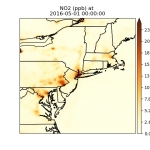Climate Tech Firm Scepter, Inc. Engages AER to Monitor Greenhouse Emissions From Space
SAN FRANCISCO–(BUSINESS WIRE)–Scepter, Inc., an emerging company backed by L37 Ventures and TableRock that uses global Earth and space-based data to measure air pollution in real time, has today announced a collaboration with Atmospheric and Environmental Research (AER), a Verisk business.
The agreement comes as the COP26 environmental summit in Glasgow meets, and it will unite an up-and-coming player with a trusted environmental trailblazer. AER has made its name sensing, simulating, modeling and predicting weather-related phenomena in the atmosphere, ocean and space for a wide spectrum of federal agencies and commercial customers since 1977. AER’s greenhouse gases team has decades of experience in combining remote sensing and dispersion modeling to measure greenhouse gas emissions locally and globally.
The alliance with AER will allow Scepter to sharply and quickly boost its atmospheric data-collection and data-fusion capabilities for both industry and government. “We brought in a top player to accelerate our time to market, sort of like bringing in the Marines,” said Scepter CEO Philip Father.
“AER brings deep scientific understanding combined with practical, hands-on experience and is critical to our mission of deploying a global methane-detection information system designed to meet the operational needs of the energy industry,” continued Father. “We’re working with the industry to solve the methane problem rather than point fingers—we’ve actually co-crafted this detection system with a Fortune 10 energy firm.”
Scepter will deploy an array of satellites with multiple sensors on each to monitor not only methane but particulate matter and other pollutants in real time. This technique complements other available sensor platforms operating at different heights such as aircraft, drones and ground sensors. Scepter’s big data capabilities can in turn fuse the entire sensor stack for a more accurate understanding of the dynamic nature of the atmosphere.
“We are currently in the early stages of commercializing reliable global measurements of methane and other gases. This is a really important period to advance the state of the art to address critical climate and human health concerns. AER is proud to work with Scepter in contributing to a greater understanding of how we can address this incredibly important issue,” said David Hogan, Senior Vice President of Strategic Business at AER.
As the United Nations’ COP26 summit gathers and the Biden Administration works to include green tech in its Build Back Better infrastructure plan, the capital markets are racing to get on board, and oil and gas interests say they welcome unbiased satellite monitoring. At the U.N. summit, the U.S. and Europe, as well as a host of multinational corporations, are widely expected to advocate satellites to monitor emissions.
According to research by Josephine Millward, head of research at Seraphim Capital, a growing number of companies are setting net zero carbon emissions targets by 2050. Furthermore, for the first half of 2021, one-fifth of the world’s largest publicly traded companies have committed to net zero, and many more Fortune 500 companies have followed. To accomplish these goals, companies will need to establish a baseline and the ability to monitor and track change in their operations. Millward said in an August report, “At Seraphim Capital, we see the rise of ESG [Environmental, Social and Governance] to combat climate change as a massive opportunity for space.”
ABOUT SCEPTER
Scepter has developed and patented a ground-breaking approach to monitoring the atmosphere in real-time using an array of terrestrial, airborne and Low-Earth-Orbit satellite-based sensors to provide actionable information for businesses, consumers, governments and NGOs.
These capabilities are not only critical for solving the global pollution and climate change crises, but also provide the platform for an emerging multibillion-dollar commercial atmospheric monitoring services industry with markets in government, energy, industrial, healthcare, agriculture, insurance, cosmetics and more. Scepter distinguishes itself among other air monitoring entities in that its measurements are in real-time and measure a variety of emissions: particulates, methane and other criteria pollutants. The unique qualities of Scepter’s process are reflected in patents awarded to the company in the U.S. and internationally. For more on Scepter, visit www.ScepterAir.com.
ABOUT AER
Atmospheric and Environmental Research (AER) provides science-based solutions to global environmental challenges. AER’s internationally renowned scientists and software engineers collaborate to transform state-of-the-art predictive science and analytical tools into practical systems that address both civilian government and defense needs for geophysical understanding, computer simulation and forecasting. AER customers include government agencies and national laboratories, aerospace and defense contractors, and academia. Areas of expertise comprise atmospheric and environmental science, air quality, remote sensing, meteorology, oceanography, space science, climate change and satellite ground processing systems. A Verisk (Nasdaq:VRSK) business, AER was established in 1977 and is headquartered in Lexington, Massachusetts. Visit www.aer.com.
Contacts
Gary Start at gstart@scepterair.com
Scott Luce at Scott.luce@aer.com




